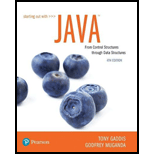
Concept explainers
Conversion
Write a program that asks the user to enter a distance in meters. The program will then present the following menu of selections:
- 1. Convert to kilometers
- 2. Convert to inches
- 3. Convert to feet
- 4. Quit the program
The program will convert the distance to kilometers, inches, or feet, depending on the user’s selection. Here are the specific requirements:
- • Write a void method named showKi1ometers, which accepts the number of meters as an argument. The method should display the argument converted to kilometers. Convert the meters to kilometers using the following formula:kilometers = meters * 0.001
- Write a void method named showlnches, which accepts the number of meters as an argument. The method should display the argument converted to inches. Convert the meters to inches using the following formula:inches = meters * 39.37
- Write a void method named showFeet, which accepts the number of meters as an argument. The method should display the argument converted to feet. Convert the meters to feet using the following formula:feet = meters * 3.281
- Write a void method named menu that displays the menu of selections. This method should not accept any arguments.
- The program should continue to display the menu until the user enters 4 to quit the program.
- The program should not accept negative numbers for the distance in meters.
- If the user selects an invalid choice from the menu, the program should display an error message.
Here is an example session with the program, using console input. The user’s input is shown in bold.
Enter a distance in meters: 500 [Enter]
- 1. Convert to kilometers
- 2. Convert to inches
- 3. Convert to feet
- 4. Quit the program
Enter your choice: 1 [Enter]
500 meters is 0.5 kilometers.
- 1. Convert to kilometers
- 2. Convert to inches
- 3. Convert to feet
- 4. Quit the program
Enter your choice: 3 [Enter]
500 meters is 1640.5 feet.
- 1. Convert to kilometers
- 2. Convert to inches
- 3. Convert to feet
- 4. Quit the program
Enter your choice: 4 [Enter]
Bye!
Want to see the full answer?
Check out a sample textbook solution
Chapter 5 Solutions
EBK STARTING OUT W/JAVA:...DATA...
Additional Engineering Textbook Solutions
Introduction To Programming Using Visual Basic (11th Edition)
Starting Out with Programming Logic and Design (5th Edition) (What's New in Computer Science)
Starting Out with Python (4th Edition)
Starting Out With Visual Basic (8th Edition)
Computer Science: An Overview (13th Edition) (What's New in Computer Science)
Starting Out with Java: From Control Structures through Objects (7th Edition) (What's New in Computer Science)
- I need help in explaining how I can demonstrate how the Laplace & Inverse transformations behaves in MATLAB transformation (ex: LIke in graph or something else)arrow_forwardYou have made the Web solution with Node.js. please let me know what problems and benefits I would experience while making the Web solution here, as compared to any other Web solution you have developed in the past. what problems and benefits/things to keep in mind as someone just learningarrow_forwardPHP is the server-side scripting language. MySQL is used with PHP to store all the data. EXPLAIN in details how to install and run the PHP/MySQL on your computer. List the issues and challenges I may encounter while making this set-up? why I asked: I currently have issues logging into http://localhost/phpmyadmin/ and I tried using the command prompt in administrator to reset the password but I got the error LOCALHOST PORT not found.arrow_forward
 EBK JAVA PROGRAMMINGComputer ScienceISBN:9781305480537Author:FARRELLPublisher:CENGAGE LEARNING - CONSIGNMENTProgramming Logic & Design ComprehensiveComputer ScienceISBN:9781337669405Author:FARRELLPublisher:Cengage
EBK JAVA PROGRAMMINGComputer ScienceISBN:9781305480537Author:FARRELLPublisher:CENGAGE LEARNING - CONSIGNMENTProgramming Logic & Design ComprehensiveComputer ScienceISBN:9781337669405Author:FARRELLPublisher:Cengage EBK JAVA PROGRAMMINGComputer ScienceISBN:9781337671385Author:FARRELLPublisher:CENGAGE LEARNING - CONSIGNMENT
EBK JAVA PROGRAMMINGComputer ScienceISBN:9781337671385Author:FARRELLPublisher:CENGAGE LEARNING - CONSIGNMENT C++ Programming: From Problem Analysis to Program...Computer ScienceISBN:9781337102087Author:D. S. MalikPublisher:Cengage Learning
C++ Programming: From Problem Analysis to Program...Computer ScienceISBN:9781337102087Author:D. S. MalikPublisher:Cengage Learning Programming with Microsoft Visual Basic 2017Computer ScienceISBN:9781337102124Author:Diane ZakPublisher:Cengage Learning
Programming with Microsoft Visual Basic 2017Computer ScienceISBN:9781337102124Author:Diane ZakPublisher:Cengage Learning Microsoft Visual C#Computer ScienceISBN:9781337102100Author:Joyce, Farrell.Publisher:Cengage Learning,
Microsoft Visual C#Computer ScienceISBN:9781337102100Author:Joyce, Farrell.Publisher:Cengage Learning,





